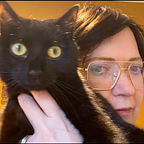Turning People Into Demons
In the early 1980s, my mom claimed to see demons everywhere, coiling around drivers who cut her off, perching on department store shoppers, floating above strangers walking down the road. Nearly everyone who didn’t agree with my mom was possessed, it seemed, from secular news anchors to the teachers at my fundamentalist school, who were the wrong kind of Christian. (They didn’t speak in tongues, play tambourines, lay on hands, or comprehend the immediate peril of Satan’s minions, so their beliefs were unprotected, creating a doorway for the devil to do his work.)
Sometimes she described demons appearing in the guise of gargoyles, sometimes snakes or scorpions, sometimes just snarling faces. Nearly any scary thing you can imagine could have been the way a demon manifested, according to my mom then. Her fervor was most intense when I was ten or so. I didn’t do too well in math that year. Most weekday afternoons in fifth grade, I could be found trying to do homework at a church lady’s house while, on the other side of the door, my mom hollered at demons to come out of people who cursed and cried and worse.
Did she really see them, I asked. Like, actually see them there, in the room or on the television, and not just sense them in some metaphorical way? This very question was a sign of my own possession, according to my mom. I was in the clutches of a doubting demon and an Antichrist demon and an intellectual demon, all inherited from my father. If I had proper faith I wouldn’t wonder these things.
Sometimes my mom would refer to people themselves as demons, skipping the part where they were supposedly created by God and beloved of God and had just gone astray through the handiwork of Satan. Amid all this, I wasn’t able to conjure belief in a loving god, but I had no trouble believing that if I did the wrong thing I’d be possessed by thousands of demons, in danger of burning eternally in hell, left behind in the Rapture.
I’ve written about these aspects of my childhood before (and I write about them more in my forthcoming book about ancestors), but while others who’ve fled Charismatic and Pentecostal churches of their childhoods might find comfort in reading my stories and knowing they’re not alone, I’ve come to feel over the years that a danger in writing about these things for a broader audience is that they tend to be read as ha-ha dispatches from the land of weird religions rather than as a kind of sharing that might have have relevance for people who grew up in different traditions, including the tradition of no religion at all.
If I’d been asked what that relevance might be eleven years ago when I wrote, for example, about former VP candidate Sarah Palin’s connection to “spiritual warfare” teachings, I would have said that these beliefs were more widespread than people realized, that one of every four Christians worldwide associated with faiths like my mom’s, and that this demonology movement had the potential to spread further. But I didn’t foresee exactly how these impulses might be weaponized and secularized through something like QAnon. Large groups of people in this country, some with no historical allegiance to any religion, now believe that politicians and people they don’t like are Satan-worshipping pedophiles drinking the blood of children.
As many have observed, something similar happened in the Satanic Panic of the ‘80s, which stoked fears activated in the broader culture by movies like The Exorcist (1973) and The Omen (1976), and enhanced by Poltergeist (1982). It’s hard for me to know how far that kind of thinking reached outside the world of the church, because I spent those years in the grips of a religion that explicitly categorized everything it didn’t embrace as the work of Satan. (We were taught not to listen to songs on the radio because of “backward masking,” that a certain manufacturer was in league with the devil because its corporate logo was a crescent moon and stars, and so on.) But my guess is that QAnon is far more pervasive.
I realize that my mom and her church and others like it aren’t a stand-in for Q believers, but they are precursors and in many cases participants. And I know, from long experience arguing with my mom, how difficult this way of looking at the world — that someone you don’t agree with is the literal incarnation of evil — can be for believers to let go of. For many of them, it’s a kind of comfort, a form of wish fulfillment. They don’t have to care about systemic injustices when they’ve identified the crowning injustice! (Never mind that it’s fictional.)
I wish I had some unique ideas about how to push back, how to identify and reach out to the reachable, but I don’t. I want to approach the problem with compassion that I have trouble accessing.
